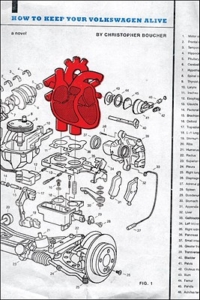by Eamon O’Connor & You!
Yesterday we posted a review of How To Keep Your Volkswagen Alive that was done in the style of Madlibs. We invited our comments section to help fill it out. Today, we’ve posted the proper review. Check below for the version filled out by some creative commenters!
In college, I had a ________(noun) who urged us to _________(verb) a text by asking three questions of it, in order: 1) _________(question)? 2) _________(question) 3) ___________(question)? Christopher Boucher’s How To Keep Your Volkswagen Alive may be the text to confound all three inquiries. Which is not necessarily a strike against it. A book-length ___________(noun)/ ___________(noun) on owner manuals in general (and specifically John Muir’s ___________(book title)), HTKYVWA takes great pleasure in ___________(verb) and ___________ (verb) precisely these sorts of questions; unscrewing the linguistic conventions one by one revealing symmetries and symbolisms that are quite ___________(adjective) at times, if always a little ___________ (adjective).
The attentive reader may recognize a few familiar characters from previous models such as ___________ (character 1), ___________ (character 2), and ___________ (character 3), (the last of which now comes standard on most new novels) but the true protagonist of HTKYVWA is ___________ (character 4). The author foregrounds ___________ (character 4) to such an extent that it often feels as though other characters and plotlines exist as ___________ (plural noun) – necessary for all highways but not sufficient to explain the particular shapes that the road ___________(verb). Boucher spends most of the book driving ___________(character 4) as hard and as far as he can all around Western Mass, but the ride is ___________ (adjective) and often frustrating. ___________ (character 4), as you might imagine, breaks down with overuse. Luckily Boucher is a ___________ (adjective) ___________(noun) in many respects, possessed of a special skill to diagnose malfunctioning language by ear, to hear where words are misaligned or where a phrase is too worn to use.
Boucher’s auditory instincts are ___________ (just leave this one blank), and you have to admire his pluck and inventiveness in making ___________ (figure of speech). But the fact is that the he has made some ___________ (adage) in HTKYVWA – patching weak plotlines with equally flimsy material, repeating the same ___________ (facile substitution) over and over (“money” ___________ (metaphysical verb)“time,” “love” ___________(metaphysical verb) “faith,” etc.), or sometimes starting the book sputtering down the road without checking to make sure that the ___________ (body part) of the themes are aligned – and this can result in some pretty grating noises from time to time.
Boucher’s Metaphor is all ___________ (the word, the image itself) and no ___________ (the idea conveyed). What he has given us is a novel in which vehicles are constantly becoming other vehicles, shifting gears and ___________ (a word that you can’t quite remember and it’s really annoying but it’s on the tip of your tongue and you’ll remember it as soon as nobody is talking about it anymore), only to be immediately replaced by more vehicles, until there are pages and pages full of vehicles ___________ (long list of verbs), being sweetly naïve one minute and tearing hearts out of ribcages the next, such that we never actually get a moment to stop and think about what is being said, and by whom. “___________ (something French)”
I would bet that Boucher has perhaps chuckled about this himself, as the novel’s climactic scene portrays our nameless narrator literally in conversation with a ___________ (an unlikely conversationalist); no saxophone. The narrator becomes tenor by ___________ (silly-sounding word), recalibrating the rest of the novel’s metaphors around himself as the central figure. Thus despite its ___________ (literary-sounding phrase), there is heartfelt emotion at the novel’s core, and it is worth your ___________ (synecdoche) to spend some ___________ (metonymy) deciphering the machinery of the ___________ (piece of machinery).
Below is a version completed by our intrepid commenting section:
In college, I had a PARROT (noun) who urged us to EAT (verb) a text by asking three questions of it, in order: 1) IS IT TASTY (question)? 2) IS IT POETRY(question) 3) DOES IT CONTAIN GLUTEN(question)? Christopher Boucher’s How To Keep Your Volkswagen Alive may be the text to confound all three inquiries. Which is not necessarily a strike against it. A book-length TEABAG (noun)/ GARLIC KNOT (noun) on owner manuals in general (and specifically John Muir’s TREES ROCK! (book title)), HTKYVWA takes great pleasure in LIGHTING UP (verb) and TOKING (verb) precisely these sorts of questions; unscrewing the linguistic conventions one by one revealing symmetries and symbolisms that are quite TRIPPY (adjective) at times, if always a little HEAVY, MAN (adjective).
The attentive reader may recognize a few familiar characters from previous models such as Jack Sparrow (character 1), Neville Longbottom (character 2), and Jazz the jive-talking robot from Transformers (character 3), (the last of which now comes standard on most new novels) but the true protagonist of HTKYVWA is (character 4). The author foregrounds Fender-Belly Bodine(character 4) to such an extent that it often feels as though other characters and plotlines exist as chickens (plural noun) – necessary for all highways but not sufficient to explain the particular shapes that the road murders (verb). Boucher spends most of the book driving Fender-Belly Bodine (character 4) as hard and as far as he can all around Western Mass, but the ride is high-pistched (adjective) and often frustrating. Fender-Belly Bodine (character 4), as you might imagine, breaks down with overuse. Luckily Boucher is a cumbersome (adjective) fern (noun) in many respects, possessed of a special skill to diagnose malfunctioning language by ear, to hear where words are misaligned or where a phrase is too warn to use.
Boucher’s auditory instincts are ___________ (just leave this one blank), and you have to admire his pluck and inventiveness in making FLIGHTS OF FANCY (figure of speech). But the fact is that the he has made some GLASSES HALF EMPTY OR HALF FULL (adage) in HTKYVWA – patching weak plotlines with equally
flimsy material, repeating the same LEMONS AS LEMONADE (facile substitution)
over and over (“money” “EXISTENCE” (metaphysical verb)“time,” “love” “FORGETTING” (metaphysical verb) “faith,” etc.), or sometimes starting the book sputtering down the road without checking to make sure that the ELBOWS (body part) of the themes are aligned – and this can result in some pretty grating noises from time to time.
Boucher’s Metaphor is all TOOTHPASTE (the word, the image itself) and no SHINY WHITE TEETH (the idea conveyed). What he has given us is a novel in which vehicles are constantly becoming other vehicles, shifting gears and KOWTOWING (a word that you can’t quite remember and it’s really annoying but it’s on the tip of your tongue and you’ll remember it as soon as nobody is talking about it anymore), only to be immediately replaced by more vehicles, until there are pages and pages full of vehicles FLOWING,FREEZING, THAWING, MELTING, BOILING, and EVAPORATING (long list of verbs),being sweetly naïve one minute and tearing hearts out of ribcages the next,such that we never actually get a moment to stop and think about what is being said, and by whom. “JE M’APELLE HELEN (something French)”
I would bet that Boucher has perhaps chuckled about this himself, as the novel’s climactic scene portrays our nameless narrator literally in conversation with a MARMADUKE (an unlikely conversationalist); no saxophone. The narrator becomes tenor by CHEROOT (silly-sounding word), recalibrating the rest of the novel’s metaphors around himself as the central figure. Thus despite its DECONSTRUCTIONPAPER (literary-sounding phrase), there is heartfelt emotion at the novel’s core, and it is worth your CHARLIEKAUFMAN (synecdoche) to spend some CAPITAL (metonymy) deciphering the machinery of the V-8 DIFFERENCE ENGINE (piece of machinery).
This post may contain affiliate links.








